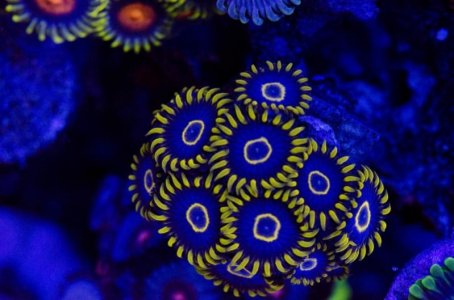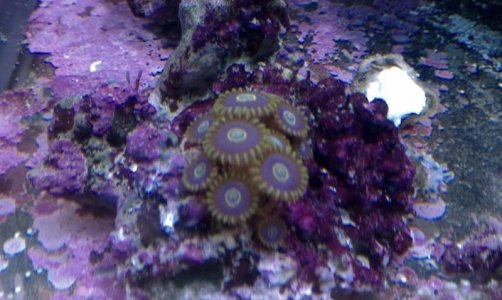herring_fish
Crazy Designer
I am wondering if there is much knowledge build up about the quantity of blue light in a display tank. With the proliferation of large arrays of LED's, many people are playing with light balances that are non-traditional.
While some people like 14K metal halides or lower and others like 20K's. More people can now settle on things like PAR levels, after K rate corrections, growth vs bleaching etc. Now that white LED's are getting more popular, similar discussions are finding some consensus around PAR and other factors. When we move over to blue lighting I haven't found as much information about blue light.
I posted some time back and got more feedback about brands, countries of origin, construction and other factors. Of course I asked the question in a way that required responses along those lines and they were appropriate for where I was at the time. I was cautioned away from having 50 watt 455nm lamps on a 24 inch deep tank along with MH's but this is getting to specifics. Right now I am starting from scratch so I want to start in general terms before I turn to the specifics. While I still need schooling in that area, I want to get to just the amounts of blue light and perhaps a little about spectrum.
Although I have been reefing for 24 years it's hard to describe what I am looking for because I am so new to this part of aesthetics. Many people like myself like the look of lots of blue LED's. In the presents of good metal arch white or LED white light, it can be hard to get a blue overtone in addition to or over the top of the white. For that reason I think, more is better but that might me a bad idea.
Of course, there is the pop that ultra-violate light can provide to the fluorescing corals but many people also like a balance that is dominated by the deep blue look of Royal Blue.
In addition to something like 420, some of us try to build just the right combination of 450, 455 and 460nm light arrays. To us, they just look brighter, bluer. A large part of this is, in some cases, purely for cosmetic reasons and not for coral growth.
In our old tanks, we didn't add too much white light or we might burn our corals. After allotting space for the white light, we didn't fill every remaining available square inch of space over the tank with actinics. I didn't see much difference between a little and a whole lot but not many people told me not to overdo it with VHO or T5 actinic light. Is some cases we were told not to even include actinic light in our total wattage calculations for optimal, safe growth. Now we can burn corals with 420nm LED's.
Now days you can get LED arrays that have 1, 3, 10, 50 watts per lamp and so on. Additionally, you can put hundreds of LED's in a given fixture. Then there are controllers that change the intensity during the day. Total lighting during the day might be fine while the peaks could be too much.
So "¦. Aside from what kind of blue LED, HOW MUCH BLUE LIGHT IS TOO MUCH?
Of course tank depth is a factor and what kind of coral is important but I hope that I can get some feedback on this side of lighting.
For reference: I happen to be starting a new 180 gallon tall tank from scratch (72''Length x 31''Tall x 18''Deep). I plan on having a mixed reef. I plan on getting an "œappropriate amount of white light be it MH's or LED's or both. I am now starting to design my DIY lighting and a little help would be appreciated.
I think you in advance.
While some people like 14K metal halides or lower and others like 20K's. More people can now settle on things like PAR levels, after K rate corrections, growth vs bleaching etc. Now that white LED's are getting more popular, similar discussions are finding some consensus around PAR and other factors. When we move over to blue lighting I haven't found as much information about blue light.
I posted some time back and got more feedback about brands, countries of origin, construction and other factors. Of course I asked the question in a way that required responses along those lines and they were appropriate for where I was at the time. I was cautioned away from having 50 watt 455nm lamps on a 24 inch deep tank along with MH's but this is getting to specifics. Right now I am starting from scratch so I want to start in general terms before I turn to the specifics. While I still need schooling in that area, I want to get to just the amounts of blue light and perhaps a little about spectrum.
Although I have been reefing for 24 years it's hard to describe what I am looking for because I am so new to this part of aesthetics. Many people like myself like the look of lots of blue LED's. In the presents of good metal arch white or LED white light, it can be hard to get a blue overtone in addition to or over the top of the white. For that reason I think, more is better but that might me a bad idea.
Of course, there is the pop that ultra-violate light can provide to the fluorescing corals but many people also like a balance that is dominated by the deep blue look of Royal Blue.
In addition to something like 420, some of us try to build just the right combination of 450, 455 and 460nm light arrays. To us, they just look brighter, bluer. A large part of this is, in some cases, purely for cosmetic reasons and not for coral growth.
In our old tanks, we didn't add too much white light or we might burn our corals. After allotting space for the white light, we didn't fill every remaining available square inch of space over the tank with actinics. I didn't see much difference between a little and a whole lot but not many people told me not to overdo it with VHO or T5 actinic light. Is some cases we were told not to even include actinic light in our total wattage calculations for optimal, safe growth. Now we can burn corals with 420nm LED's.
Now days you can get LED arrays that have 1, 3, 10, 50 watts per lamp and so on. Additionally, you can put hundreds of LED's in a given fixture. Then there are controllers that change the intensity during the day. Total lighting during the day might be fine while the peaks could be too much.
So "¦. Aside from what kind of blue LED, HOW MUCH BLUE LIGHT IS TOO MUCH?
Of course tank depth is a factor and what kind of coral is important but I hope that I can get some feedback on this side of lighting.
For reference: I happen to be starting a new 180 gallon tall tank from scratch (72''Length x 31''Tall x 18''Deep). I plan on having a mixed reef. I plan on getting an "œappropriate amount of white light be it MH's or LED's or both. I am now starting to design my DIY lighting and a little help would be appreciated.
I think you in advance.









